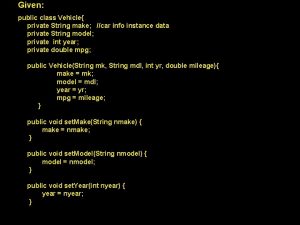Development of Autonomous Control Autonomous Vehicle for Multiple

- Slides: 1

Development of Autonomous Control Autonomous Vehicle for Multiple. Surface Vehicle Platforms Collin Gagnon, Alexander Roemer, Steven Hurley, Robert Mitchell, Jeffrey Hensel, Allisa Dalpe Nate Bredow, Aaron Cordova, Brandon Wong, Daniel Cohen, Kara Graney, Brian Ellis, Chris Chin, Kim Radzelovage Advisor: Dr. May-Win Thein Graduate Researcher: Allisa Dalpe Graduate Advisors: John Mc. Cormack, Sital Khatiwada University of New Hampshire Abstract UNH ROV is an interdisciplinary engineering team dedicated towards the design and fabrication of an underwater remotely operated vehicle. This year, ROV 006, known as Njord, was designed for the use and implementation of graduate and doctoral research. Computer-aided modeling software, Solid. Works, was the platform for the design model of this year’s ROV. The use of both acrylic sides and 80/20 aluminum connectors in the chassis were inspired from both ROV 003 ‘Viper’ and ROV 005 ‘Siren’. Innovations to improve Njord from previous year’s designs include a vertical electronics tube, two electronics tiers for more compact wiring, multiple cameras, improved userfriendly computer coding, and an expandable wiring platform for the possible addition to the sensor array on board. Current ongoing tasks include implementing a stabilizing control code and communication with the Autonomous Surface Vehicle (ASV). With new and innovative ideas, various engineering programs, and a unique and expandable design, Njord establishes its role as an advanced underwater ROV platform for many aspects of research, industrial application, and the marketable world. Objectives As a senior design project team working to influence graduate research, the goal for the team is to design and build a working underwater remotely operated vehicle that can be used as a research platform. The ultimate goal for years to come is to create a fleet of Autonomous Underwater Vehicles (AUV), Autonomous Surface Vehicles (ASV) and Unmanned Aerial Vehicles (UAV) to communicate together and accomplish a goal. The primary goal of the ROV team this year is to produce a research based ROV that is technologically and computationally superior to previous year’s models by adding new advancements. This new design provides a working base model to further establish communication with an ASV. Stability Feedback Control Electrical System • Will allow the ROV to maintain position and orientation while experiencing external disturbances • Linear-quadratic regulator allows for the control of a non-linear system • Minimizes a cost function with user supplied weighting factors • 9 DOF IMU allows for the system to detect and compensate for changes in position and orientation • Stability system can be adapted to aid in future autonomy systems • Will be able to aid in future track-and-trail operations • The LQR controller will be constructed using a Python Control System Library. • The function call is “lqr(A, B, Q, R)”, where A and B are 2 -D dynamic and input matrices, and Q and R are state and input weight matrices. Sensors Future AUV Goals Once communication is perfected between the ROV and ASV, future years’ ROV teams will establish a fully autonomous ROV. From there, fleets of AUVs and ASVs will have full communication with one another for various research opportunities • Razor 9 DOF IMU contains a gyroscope, accelerometer, and magnetometer. The IMU will be utilized in the stabilization control • Blue Robotics Bar 30 sensor. Measures pressure and temperature • Vernier salinity sensor • 2 board cameras mounted on the front of the ROV. Provide a live video to the surface. Allow for future members to explore the ROV’s computer vision capabilities ROV-ASV Communication • Currently researching acoustic options for ROV tracking relative to the ASV platform • Acoustic signals travel well through water • Future researchers will be able to coordinate movement and share data between ROV and ASV systems • The ASV will provide broad search capability while the ROV will be deployed to examine the seafloor in higher resolution Acknowledgments Many thanks to Dr. Martin Renken (Keyport NUWC), NAVSEA, NEEC, and to the New Hampshire Sea Grant for their respective contributions to the development of this research and for their time spent ensuring our success. We would also like to thank Joseph Gabriel (Form 3 D), Scott Campbell (UNH Machine Shop), and Tara Hicks Johnson (UNH Ocean Engineering). Chassis Design • • • Electronics Trays Cast Acrylic Plastic and 80/20 T-slotted Aluminum Frame Lightweight design for easy transportation Slide fastener system allows for easy attachment of components 8 Thrusters with a maximum thrust of 5. 2 lbf each Vertically-oriented watertight electronics enclosure Two (2’’ dia. ) watertight tube enclosures for sensors/cameras • Two tier cylindrical design to reduce wiring • 6061 aluminum plates chosen for thermal properties • Plates connected with removable stainless steel rods • Handle added for easy removal from tube

